|
St. Petersburg
St. Petersburg founded in 1703 is one of the most important scientific, cultural and tourist centers not only in Russia, but also worldwide. Unique architectural ensembles, enchantment of numerous rivers and canals, attire of suburban palace-and-park ensembles-all this makes the image of St. Petersburg inimitable and enticing. St. Petersburg is called the cultural capital of Russia. There are over hundred museums in the city, including the Hermitage and the Russian Museum with their invaluable collections; lots of musical and theatre festivals and exhibitions are held.
It would be provided also pre- and post-conference tours to Moscow and Veliky Novgorod.
We hope that your stay in St. Petersburg will give you the unforgettable feelings.
THE HERMITAGE
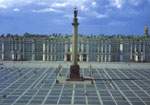 Address: Dvortsovaya emb., 34 Address: Dvortsovaya emb., 34
Open: Tuesday-Sunday from 10:30 to 5:00.
Situated in the centre of Saint-Petersburg the State Hermitage Museum is housed in five magnificent buildings created by celebrated architects of the 18th to 19th century. The Winter Palace, formerly the residence of Russian Emperors which was constructed between 1754 and 1762 after a design of Bartolomeo Rastrelli, occupies an important place amongst other constructions of the whole Museum ensemble. The architect designed the palace as a part of the city landscape - a huge closed space with an inner court and free facades secluded from all other buildings.
Francesco Bartholomeo Rastrelli said about his creation, the Winter Palace, that it was constructed "...for the glory of Russia solely" and was to become the embodiment of greatness and power of Russia that in the mid 18th century became one of the most significant countries. The Winter Palace startles with grandeur scale, luxury and variety of ornamentation, integrity and proportionality. This building presents all characteristic features of Rastrelli's style, the Russian Baroque style: majestic gala forms, abundance of decorative details, irrepressive brilliancy, luxury and buoyancy.
During the reign of Catherine II the grandeur palace ensemble became the official residence and the storehouse of the art treasures, also private appartments of the Russian Empress was erected. After the death of Catherine II the Winter Palace became deserted.
On 7 February 1852 in the building of the New Hermitage the first Russian public museum was open for the visitors. The tradition of collecting works of art became a part of the state policy. 19th century brought changes into the life of the royal residence. Interiors of the palace ensemble were changed according to the new tastes. Official and private life of the members of the royal family was connected with the walls of the palace, as well as the last page of the reign of the Romanov’s dynasty.
By the end of the reign of Nicholas I the "public Museum of the New Hermitage", that already possessed one of the world best collections of the West-European art, built up new collections - of Antiquities and of Oriental Art, the Gallery of Jewellery and the Gallery of Peter I, and became famous in Europe.
Put together throughout two centuries and a half, the Hermitage collections of works of art (over 3,000,000 items) present the development of the world culture and art from the Stone Age to the 20th century.
Today the Museum is creating its digital self-portrait to be displayed around the world. Computer technologies enable the State Hermitage Museum to provide people from all over the world with wider access to information about the Museum and its treasures.
up
THE RUSSIAN MUSEUM
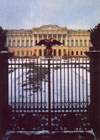 Address: Inzhenernaya St., 4 Address: Inzhenernaya St., 4
Open: daily, except Tuesdays, from 10a.m. to 6.00p.m., on Mondays from 10.00a.m. - 5.00p.m.
The State Russian Museum is the world's largest museum of Russian art. The museum is housed in four palaces located in the historical center of Saint-Petersburg. Together, these buildings present a retrospective panorama of Russian architecture - Baroque (Stroganov Palace), early and late Neoclassicism (Marble Palace, St. Michael's Palace).
From Nevsky Prospect, the central magistral of Saint-Petersburg, you can enjoy the view of a beautiful building, both monumental and light, with gracious portico of classic Corinthis order. It is the main buildind of the museum on the Art Square, in the Former Palace of Grand Duke Michail Pavlovich ("Mikhailovsky Palace"), which houses the main compositions. If you walk from the main building up to the Nevsky Prospect and then turn to the right, you will see the plastic front of the oldest Stroganov Palace, named after its owners, the Stroganovs. Then you can make a wonderful walk along the embankment of the Moika river. When you come to the Mars Square, to the left you will see the Marble Palace, built in the late Neoclassicism style. And to the right you will see the romantic silhouette of St. Michael's (Engineers) Castle. The Stroganov Palace, Marble Palace and St.Michael's Castle passed awarded to the Russian Museum between 1989 and 1994.
The collection of the Russian Museum numbers some 400,000 works and covers the entire history of Russian fine art from the 10th century to the present day. It reflects virtually every form and genre of art in Russia, including a unique collection of Old Russian icons, works of painting, graphic art and sculpture, decorative and applied art, folk art and numismatics, as well as the world's finest collection of Russian avant-guarde.
Today the unique and comprehensive collection of the Russian Museum is an exceptional opportunity of an all-round, detailed study of the development of artistic ideas and culture in Russia over a period of nearly two and a half centuries.
In 1998 the State Russian Museum celebrates its century jubilee. There was series of exhibitions entitled World Museums and Galleries on the Occasion of the Russian Museum Centenary. Visitors will also be able to see the newly restored halls of its three new palaces. There is also a series of books devoted to the collections and history of the Russian Museum.
up
THE SAINT ISAAK'S CATHEDRAL
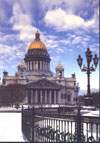 St.Isaac's Cathedral is a remarkable monument of Russian architecture. This grand structure filled up the space of the Senate Square, and created a new square as well. Alongside with the Peter and Paul's Cathedral and the Admiralty it became an important architectural landmark in the city outline. The golden dome of St.Isaac's can be seen from any part of the city, and in clear weather - even from the suburbs. St.Isaac's Cathedral is a remarkable monument of Russian architecture. This grand structure filled up the space of the Senate Square, and created a new square as well. Alongside with the Peter and Paul's Cathedral and the Admiralty it became an important architectural landmark in the city outline. The golden dome of St.Isaac's can be seen from any part of the city, and in clear weather - even from the suburbs.
The history of the construction began in 1710, when the first wooden church was put up in honor of St.Isaac of Dalmatia; it was on St.Isaac's day, according to the Orthodox calendar, that Peter I was born. The present Cathedral is the fourth erected on the site. In the early 19th century a contest was arranged for the best project of a new cathedral, in which the most well-known architects took part. In 1818 Alexander I approved a project submitted by A.Montferrand, a talented drawer who had just arrived from Paris; however, he had had but little experience in architecture.
It took forty years to build the cathedral. Three years after the construction had started it came to a halt because of a number of mistakes made in the project and during the building process. A special commission of notable Russian architects was formed. In 1825 the construction works were resumed according to the corrected project. Lots of complicated engineering problems were to be solved for the first time in history.
In 1828, even before the walls were erected, installation of the 48 monolithic columns was started, that were to form the porticoes, each weighing about 110 tons. The ideas of A.Betancourt, an engineer, made it possible to raise the 67-ton granite columns to the height of 40 m and install them around the dome drum.
St.Isaac's Cathedral is one of the largest domed structures in the world. The building, being rectangular in its layout, rose 101.5 m high. Having the area of 4 thousand sguare meters, the Cathedral can hold up to 12 thousand people. The dome is of an original construction, practically including three domes, placed one over other.
The cathedral, faced with light-gray marble from Olonetsk, was completed by 1842; however, it took sixteen years more to decorate the interior. A lot of valuable materials were used, among them lazurite, malachite, porphyry, all kinds of marbles. The walls and vaults of the cathedral bear paintings and mosaic works made by well-known Russian artists: C.Briullov, F.Bruni, P.Basin, P.Shebuyev and others. On the whole more than 200 artists took part in the works. The great plafond of the big dome with the area of more than 700 square meters was painted by C.Briullov.
Both inside and outside the cathedral is decorated with sculptures made to the designs by I.Vitali, N.Pimenov, A.Loganovsky, P.Klodt and others. It was for the first time that the galvanoplastics method developed by B.Yakoby was used for making monumental sculptures.
The cathedral, that stands out for its grandeur, was sanctified in 1858 and became the main church in Saint-Petersburg.
up
THE YUSSUPOVS' PALACE
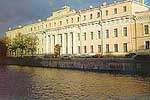 Address: Moyka riv. emb., 94 Address: Moyka riv. emb., 94
Open: Mon-Sun from 11a.m. to 4p.m.
In XVIII there used to be a manson built in 1790s that belonged to Count Shuvalov. Since 1830 it became property of Prince Yussupov, one of the richest men of Russia.
The Yussupovs made a rich collection of painting, sculpture and applied art pieces.
In 1918, after the October Revolution, the palace was confiscated and the collection was partly sold out, partly moved into the State Hermitage.
For several years the palace housed a museum, and since 1925 it has been the House of Enlightment Workers.
up
PETERHOF
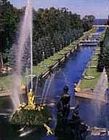 The world-famous palace, fountain and park ensemble of Peterhof is an outstanding landmark of Russian artistic culture of the 18-19th centuries. Founded in the very beginning of the eighteenth century by Emperor Peter the Great not far from his new northern capital St Petersburg, Peterhof was intended to become the most splendid official royal summer residence. The world-famous palace, fountain and park ensemble of Peterhof is an outstanding landmark of Russian artistic culture of the 18-19th centuries. Founded in the very beginning of the eighteenth century by Emperor Peter the Great not far from his new northern capital St Petersburg, Peterhof was intended to become the most splendid official royal summer residence.
Credit for its creation should go to a great number of eminent architects, artists, and anonymous folk craftsmen. Its wonderful parks, 176 fountains of various forms and styles and four cascades, majestic palaces, numerous gilded statues of ancient gods and heroes, remarkable collections of sculpture, painting and works of the minor arts make Peterhof a veritable gem of art, often called "Capital of Fountains", unique in the world.
After 1917 the Peterhof ensemble was taken into state custody and turned into architecture and art museum. Nowadays, due to the unforgettable beauty of its fountains, parks and palaces, Peterhof has become the most attractive for numerous Russian and foreign visitors suburban royal park and palace ensemble of the northern Russia's capital. To feel happy, to make their spirits high, people often come to Peterhof and enjoy its magic charms.
up
PAVLOVSK
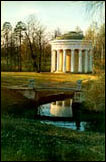 A superb palace and park ensemble, dating from the late 18th to the 19th century, Pavlovsk was a summer residence of the Russian emperor Paul I and his family. Its architects were amongst the greatest of the period: Cameron, Brenna, Quarenghi, Voronikhin and Rossi. The landscape park, one of the largest in Europe, covers an area of 600 hectares. A superb palace and park ensemble, dating from the late 18th to the 19th century, Pavlovsk was a summer residence of the Russian emperor Paul I and his family. Its architects were amongst the greatest of the period: Cameron, Brenna, Quarenghi, Voronikhin and Rossi. The landscape park, one of the largest in Europe, covers an area of 600 hectares.
The formation of the Pavlovsk Palace collections was closely connected with the journey by its owners through Europe in 1781-82. They visited workshops of well-known artists, ordering and acquiring paintings, furniture, bronze articles, silk fabrics, china sets, etc. They also brought back to Russia a large number of antique sculptures from Italy, and gifts from European royal courts. Many of these treasures are on view, together with an excellent collection of portraits by Russian artists, and a number of Pavlovsk landscape paintings and drawings.
Following a long restoration, the ravishingly beautiful private rooms of Empress Maria Fedorovna, which were decorated Quarenghi and Voronikhin, are again open to the public.
up
PUSHKIN (TSARSKOYE SELO)
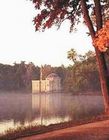 Catherine Park Catherine Park
Catherine Park is a wonderful work of the Russian art of gardening from the 18th and 19th centuries, which combines the masterpieces of architecture with the beauty of the transforming nature of the north.
In its landscaping one can find the features of different garden styles.
The Regular part of the park lies between the Catherine Palace, the Great Pond and the Cascade ponds. It is created according to Rastrelli's design and constructed by the master gardener Ya Rekhlin. It's historic name is the Old Garden. It was originally planted at the beginning of the 18th century in front of the palace of Catherine I. In the 1750's the park was decorated with numerous entertaining pavilions. The landscaping was designed in the second half of the 18th century and is situated beyond the Cameron Gallery. During the same period of time, the park was being filled with architectural designs which revived the forms of military monuments of ancient Rome and the style of the medieval buildings as well as Chinese motifs.The Grand Caprice connects the Catherine Park and Alexander Park.
The Amber Room in Tsarskoe Selo covered with panels of amber, glowing and catching the light was considered to be the Eighth Wonder of the World. King Friedrich Wilhelm I of Prussia presented the room as a diplomatic gift to Peter the Great in 1717. after Peter had admired it while a guest in Charlottenburg, Berlin.
The room was first installed in the Winter Palace, but in 1755 Empress Elizabeth ordered Francesco Rastrelli to move it to the Catherine Palace. The individual amber panels were carried from St Petersburg to Tsarskoe Selo by 76 guardsmen in six days. They were not large enough to complete the new 100 m decor, so mosaic and mirror insets were added and the upper part of the walls was painted to imitate amber.
During the Second World War occupying troops removed the amber panels in September 1941, and they were brought to Alfred Rode, head of the Konigsberg Art Museum in Kaliningrad. Part of the Amber Room was last seen on display in Konigsberg Castle, before being hidden in its catacombs. From here the mystery starts. There are stories that the amber was burnt in a bomb attack, that it was moved to Germany on the personal order of Hitler himself, that it remains in the subterranean vaults of the castle, that stretch for kilometers. The most recent and hopeful theory is that, whilst being transported to Germany, the panels were dumped in a mine on the Baltic Coast.
There were 4 Florentine mosaics in the decoration of the Amber Room which had been created in Florence (Italy). The mosaics' plots are 5 allegories: hearing, taste, eyesight, sense of smell, sense of touch.
A team of amber masters of the "Tsarskoselskaya Yantarnaya Masterskaya" Ltd has worked since 1982, intent on recreating the amber room. The deep knowledge dodge of the old methods of work allowed them to replicate different lost objects having only the photos and descriptions of these ones. The work was only finished by the 300-anniversary of St.Petersburg, in May 2003.
Alexander Park
Alexander Park consists of 188 square hectares, and is divided into two parts, the Regular (new park) and the Landscape park. The first was the project of N. Jurar, under the direction of master gardeners K. Shreder and M. Kondakov. The Landscape park is located where once was the Menagerie, the part of the forest which was designated for wild animals and designed as an English Landscape park. The park was designed by A. Menelas and I. Ivanov. The parks environment is filled with decorative pavilions in medieval gothic style.
up
| 
